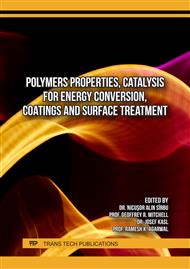p.3
p.9
p.19
p.25
p.31
p.41
p.53
p.59
p.69
Improved Performance of NiCoFe-LDH Electrocatalyst by Synthesizing on NiCo2O4 with Ni Foam for Effective Oxygen Evolution Reaction
Abstract:
In water splitting, high-performance electrocatalysts play an essential role in the oxygen evolution reaction (OER). This study focuses on preparing nanoflower-structured electrocatalysts by coating different amounts of Ni in NiCoFe double hydroxide (LDH) onto the NiCo2O4 surface on Ni foam (NF) using a hydrothermal method. The NiCoFe-LDH@NiCo2O4/NF electrocatalyst demonstrates excellent activity for OER, exhibiting low overpotential and good stability. The exceptional performance is attributed to the high electrochemically active surface area of NiCoFe-LDH when combined with NiCo2O4. The optimal Ni0.75CoFe-LDH@NiCo2O4/NF electrocatalyst demonstrates exceptional oxygen evolution reaction (OER) performance, with a low overpotential of 254mV at a current density of 50mA·cm−2. It also shows excellent durability, with minimal overshot during overall water splitting stability tests. This study suggests developing highly efficient OER catalysts using ternary transition metals in the future.
Info:
Periodical:
Pages:
31-37
Citation:
Online since:
November 2025
Authors:
Price:
Сopyright:
© 2025 Trans Tech Publications Ltd. All Rights Reserved
Share:
Citation:


